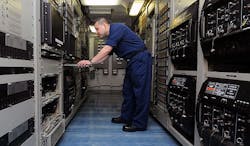Navy asks Thales to provide RF and microwave power amplifiers for AN/USC-61(C) shipboard communications
Officials of the Space and Naval Warfare Systems Command (SPAWAR) in San Diego are asking Thales Defense and Security Inc. in Clarksburg, Md., to continue building and delivering High Frequency Distribution Amplifier Group (HF-DAG) system components and engineering services.
The HF-DAG replacement program is designed as a substantial technology upgrade to the existing HF communications systems deployed on U.S. Navy ships. The HF-DAG contract calls for Thales to provide 1000-Watt power amplifiers and flexible power management units (FPMUs).
The HF-DAG supports automated communications in a wide band of frequency spectra that supports transmit and receive communications modes like duplex/simplex voice, continuous-wave (CW), teletype, digital exchange, amplitude modulation (AM) and Link 11 HF networking.
Related: Navy chooses shipboard radar power amplifiers from L3 Electron and CPI Beverly Microwave
The HF-DAG communications group supports the Navy's AN/USC-61(C) Digital Modular Radio (DMR) communications suite from the General Dynamics Corp. Mission Systems segment in Scottsdale, Ariz. The Electromet Corp. in Hagerstown, Md., provides electronic enclosures for the Navy's shipboard DMR communications suites.
The Navy awarded this contract to Thales sole-source because the company's broadband HF components are the only ones that interface with the AN/USC-61(C) DMR shipboard communications system, Navy officials say.
SPAWAR is awarding this contract on behalf of the Navy Program Executive Officer for Command, Control, Communications, Computers, and Intelligence (PEO C4I), Communication Program Office (PMW/A 170) in San Diego.
The HF-DAG supports AN/USC-61(C) maritime radios to enable Navy surface warships and submarines to communicate over high frequency (HF), ultra-high frequency (UHF) line of sight, UHF satellite communications (SATCOM), and very high frequency (VHF) radio bands.
Related: Broadband RF and microwave power amplifier for communications and EW introduced by NuWaves
The AN/USC-61(C) DMR is a shipboard software-defined radio (SDR) that has become standard for the U.S. military. The compact, multi-channel DMR provides several different waveforms and multi-level information security for voice and data communications.
The radio includes Embedded type 1 encryption; embedded red/black baseband switching and routing; co-site performance; reduced manpower requirements; single point of control for HF/VHF/UHF/SATCOM radio communications; and built-in test (BIT).
Software-defined radio waveforms are computer programs that enable SDR-enable radios to operate on different frequency bands with different encryption and cyber security functions. The AN/USC-61(C) operates on Navy surface ships, submarines, and other military platforms using frequencies from 2 MHz to 2 GHz.
General Dynamics has certified the DMR to pass secure voice and data at multiple independent levels of security (MILS) over HF, VHF, UHF, and SATCOM channels, and to withstand the effects of electromagnetic interference and other harsh operating conditions.
The DMR also is certified by the Joint Interoperability Test Command (JITC) to be compliant with the U.S. government’s MIL-STD-188-181B/182A/183A requirements for UHF SATCOM. General Dynamics builds the AN/USC-61(C) using open-architecture standards.
On this five-year HF-DAG contract, Thales will do the work in Clarksburg, Md.; and West Sussex, England, and should be finished by January 2024, For more information contact Thales Defense and Security online at www.thalesdsi.com, or SPAWAR at www.public.navy.mil.
Ready to make a purchase? Search the Military & Aerospace Electronics Buyer's Guide for companies, new products, press releases, and videos

